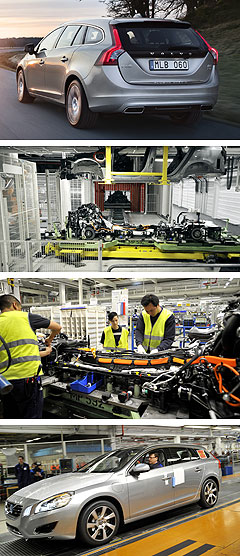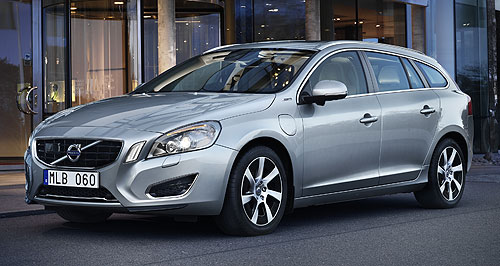Future models - Volvo - V60 - PHEVVolvo turns up wick on plug-in V60Battery ram: A lithium-ion battery pack is maneuvered into the back of a V60 PHEV on the regular production line at Volvo’s Swedish plant. Mass-production of diesel-electric Volvo V60 means big chance of local launch20 Nov 2012 VOLVO has ramped up production of its pioneering diesel-electric plug-in hybrid V60 wagon in a move that signals good news for potential customers in Australia. The Swedish company expects to build between 4000 and 6000 of the vehicles in the new model year – at least quadruple the number built in the initial trial batch of 1000 units for the current model year. For Volvo Car Australia, this means a good chance of securing stocks of the vehicle within 2013, probably in the second half. VCA public affairs manager Oliver Peagam said the V60 PHEV was still not confirmed for Australia, but the company still had its hand up for it. “We are still going through the whole process,” he said. “As we have said before, we have certainly put our hand up for it and are very keen to get it here as soon as possible.” Mr Peagam said the decision to ramp up production at Volvo’s Torslanda plant, in the company’s home town of Gothenburg, was good news for Australia as it improved the chances of approval for this country. Unlike other plug-in hybrid vehicles such as the Holden Volt, the V60 PHEV is built on the same production line as the standard V60 and S60.  From top: Volvo V60 PHEV Production of the Volvo V60 PHEV. From top: Volvo V60 PHEV Production of the Volvo V60 PHEV.Areas of the final assembly line had to be rebuilt to accommodate the process, which involves an extra 300 parts covering the electric powertrain and battery. The diesel engine, electric motor, transmission, control units and wiring are all assembled on a pallet along with the front and rear chassis, and then the body is lowered on top. The lithium-ion battery pack is then maneuvered in through the rear hatch and rotated to drop it into its housing in the wagon’s floor. The 11.2kWh 400-volt battery has sufficient power to propel the V60 for 50km on electric power, driving through the rear wheels, before the five-cylinder diesel engine kicks in, driving the front wheels. Volvo Car Corporation senior vice-president of research and development Peter Mertens said Volvo was the first company to integrate a plug-in vehicle into the regular assembly line. “The integration in the standard production flow gives the plug-in hybrid buyer the possibility to choose in principle all options available for the standard V60,” he said. The first 1000 vehicles were all pre-sold in Europe, and Volvo says orders are already flooding in for the next batch. The V60 PHEV can achieve a class-leading 1.9 litres per 100km on the European official fuel economy combined test cycle, yet can accelerate from zero to 100km/h in 6.2 seconds – equal with the current fastest V60, the turbocharged T6. The plug-in V60, which was shown in concept form at the Australian International Motor Show in Melbourne last year, is set to become VCA’s first electrified car, as the company did not offer the all-electric C30 DRIVe that was leased to customers in Europe. The V60 PHEV is expected to become the flagship of the V60 range, with a price premium above the current most expensive model, the $78,490 T6 R-Design, despite a luxury car tax discount of about $7000 due to its low fuel consumption. Although the V60 PHEV will create waves as a halo car when it arrives in Australia, VCA first will launch an even more important vehicle – the new V40 small car – in February.  Read moreAll future models Alfa Romeo Alfa Romeo Abarth Abarth Audi Audi Aston Martin Aston Martin BMW BMW Bentley Bentley Chrysler Chrysler Chevrolet Chevrolet Dodge Dodge Citroen Citroen Ferrari Ferrari DS DS Ford Ford Fiat Fiat FPV FPV Foton Foton Haval Haval Great Wall Great Wall Honda Honda Holden Holden Hyundai Hyundai HSV HSV Isuzu Isuzu Infiniti Infiniti Jeep Jeep Jaguar Jaguar Lamborghini Lamborghini Kia Kia Lexus Lexus Land Rover Land Rover Mazda Mazda Maserati Maserati Mercedes-Benz Mercedes-Benz McLaren McLaren Mini Mini Nissan Nissan Mitsubishi Mitsubishi Peugeot Peugeot Opel Opel Proton Proton Porsche Porsche Renault Renault Ram Ram Saab Saab Rolls-Royce Rolls-Royce Smart Smart Skoda Skoda Subaru Subaru SsangYong SsangYong Tesla Tesla Suzuki Suzuki Toyota Toyota Volvo VolvoV60 pricing
Motor industry news |
Click to shareVolvo modelsResearch Volvo All future models Alfa Romeo Alfa Romeo Abarth Abarth Audi Audi Aston Martin Aston Martin BMW BMW Bentley Bentley Chrysler Chrysler Chevrolet Chevrolet Dodge Dodge Citroen Citroen Ferrari Ferrari DS DS Ford Ford Fiat Fiat FPV FPV Foton Foton Haval Haval Great Wall Great Wall Honda Honda Holden Holden Hyundai Hyundai HSV HSV Isuzu Isuzu Infiniti Infiniti Jeep Jeep Jaguar Jaguar Lamborghini Lamborghini Kia Kia Lexus Lexus Land Rover Land Rover Mazda Mazda Maserati Maserati Mercedes-Benz Mercedes-Benz McLaren McLaren Mini Mini Nissan Nissan Mitsubishi Mitsubishi Peugeot Peugeot Opel Opel Proton Proton Porsche Porsche Renault Renault Ram Ram Saab Saab Rolls-Royce Rolls-Royce Smart Smart Skoda Skoda Subaru Subaru SsangYong SsangYong Tesla Tesla Suzuki Suzuki Toyota Toyota Volvo VolvoV60 pricing
Motor industry news |
















Facebook Twitter Instagram